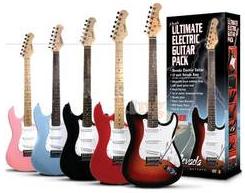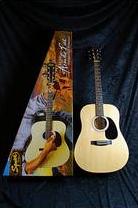You know you want to get your child a guitar for Christmas. But with all the choices out there, have you given it any thought which brand you would choose? What size guitar your child will need? Which colour? Which accessories you will need?
Finding great starter electric guitar packages for your beginning guitarist does not have to be a big chore. There are many of them available for you to choose from in a dizzying array of options, colors, and sizes.
To a parent who is looking for that perfect one to get their child started in learning a great musical instrument, this can be slightly overwhelming. You also are concerned about buying a guitar that is of good quality that your child will like and be able to use for years to come.
Guitar packages are typically the all in one answer to the problem of getting someone started with an electric guitar. Whether you would like to get them an acoustic or electric guitar, there are guitar packs out there for both instruments.
Electric guitar packs come with everything your child will need to make a sound including the guitar and amp. Acoustic guitar packs usually come with a strap, gig bag, and other essential accessories. In general, guitar packs are great value and an excellent way to get a complete beginner started with the instrument.
Choosing the Right Electric Guitar Pack
Each electric guitar pack comes with a guitar, amplifier, and other accessories that are needed to learn how to play. As someone who is searching for a Christmas gift for a loved one, this is perfect. The guitar requires an amplifier to generate the sound. If you get only the guitar, then you will need to make a separate purchase. The electric guitar package is a simple way to get them started.
Firstly, you need to know what to look for in a good guitar. Have a read through this short guide which will help you know what to look out for.
You will also need to know exactly what an electric guitar package needs to contain in order for your new player to have everything that they need to get started. In addition to the guitar, they will need to have an amplifier, a cable that hooks the guitar to the amplifier, a sturdy strap, guitar picks, and an extra set of strings.
Useful bonuses that will really help out are a tuner, guitar polish, a string winder, a case for the instrument and the best bonus, an instructional DVD. Having these items included will have your child playing it right out of the box.
Fender Squire Electric Guitar Pack £199
Fender is one of those great guitar brands that are an old favourite to beginner and experienced guitarists alike. The Fender Squire Guitar Pack is a guitar starter kit that comes with absolutely everything you need to learn how to play. This includes the Squier Affinity Stratocastor® guitar, a gig bag, a Fender® Frontman 15G amplifier, strap, guitar picks, headphones, instruction book, strings, and a cable.
Rockburn Electric Guitar Package £99
The Rockburn Electric Guitar Starter Package is the perfect guitar package to begin playing. The Rockburn guitar starter kit also comes with everything you need to get playing ‘out of the box’: Nevada electric guitar, 10 watt Rockburn amp with overdrive, EQ and headphone socket, Adjustable black webbing strap, 10ft black guitar lead, Black gig-bag, Set of nickel strings, Nevada plecs, Tutorial DVD with interactive tuning feature.
Acoustic Guitar Packages
Acoustic guitar packages are the alternative way for beginners to learn guitar. Many first time players prefer to learn the basics on an acoustic and then quickly progress onto the electric guitar. Either way is fine and there are no right or wrong ways. The Fender Squier Acoustic Guitar Package is one of the most respected starter acoustic package. Fender is one of the biggest names in te music industry and their entry level range (Squier) is ideal for beginners.
The Fender Squier SA100 Starter Package £79
The Fender Squier Starter Package contains: Squier dreadnought guitar, Gig bag, Pitch pipes, Picks, Fender instruction book












